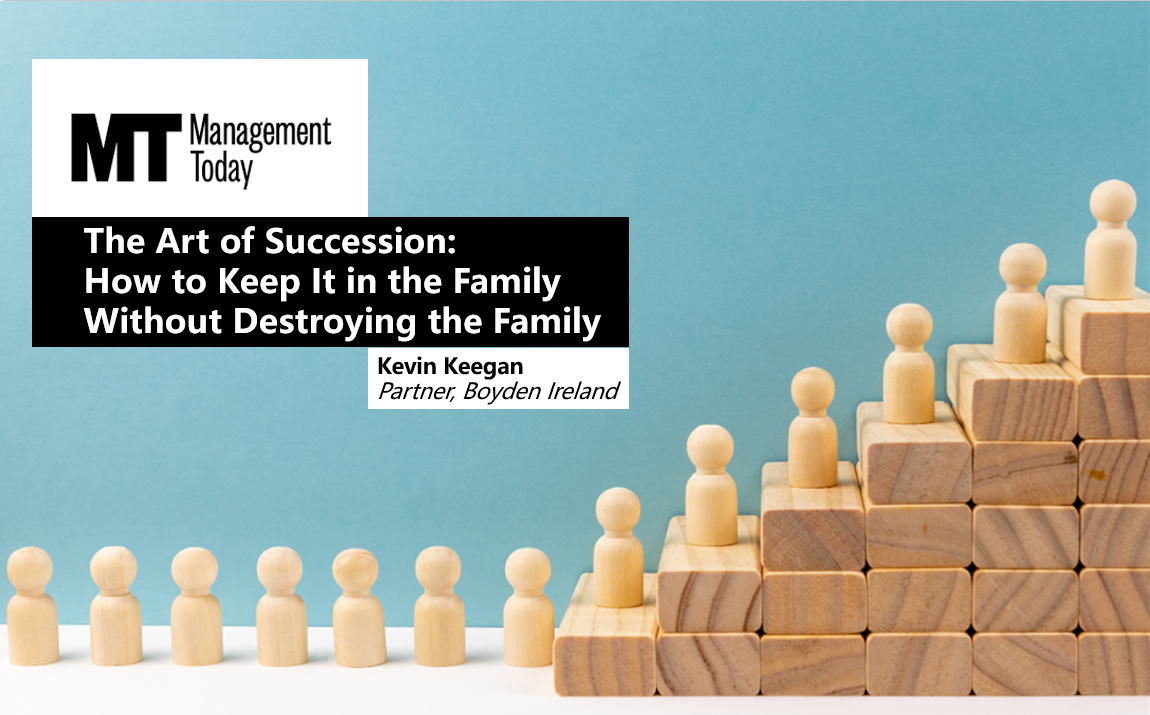CEO succession is a difficult business, not least when you're a family business, says Boyden UK & Ireland partner, Kevin Keegan.
This article was originally published by Management Today. Click here to view the original article.

Family man, shrewd Mafia boss and violent tyrant… Don Vito Corleone, in all his various personas, has been embedded in our culture since Francis Ford Coppola brought ‘The Godfather’ to our screens. The plot is dominated by the generational power transition in the Corleone empire. Clearly, we have a penchant for the subject: the finale of HBO’s ‘Succession’ reached nearly 3 million viewers.
In the last year, we’ve seen speculation about who will take the helm at LVMH and continuing feuds over the Hinduja fortune. Most recently, Lachlan Murdoch was named as heir to the throne of his father’s media empire, ending one of the business world’s most closely watched succession races.
Clearly, this subject is as pertinent as ever. And, fiction or fact, the stakes are high: less than a third of family businesses survive from first generation ownership to second. How can we improve the odds?
Changing winds beyond our control make it hard to predict business fortunes. However, certain practices could mean the difference between being in the fraction that survive and the majority that don't. Who knows? If enough family businesses took the right steps, that "less than a third" might creep up. That's my hope.
It has been my honour to work with some great family businesses to help secure their future within the kinship. Several rules of thumb have stood out to me over the last few decades that I believe are worth sharing.
1. Bring in Trusted Advisors
It is key to make a distinction between a family business and family dynamics. Keeping the two separate and engaging an intermediary helps to maintain good health in both.
Some of the most difficult situations that can arise in succession scenarios are helped by the presence of an advisory board. It is natural that the family member leading a business might hold some bias or consider factors that don't relate to the appointment. Having objective advisory board members around them whose interest is solely in the future success of the business and who aren't involved in the family, can be a valuable counterweight.
The aim is to bring these figures in well before any sensitivities around succession can come about. Advisory boards are not there to supervise new leaders, once installed; they are there to give a clear perspective on what is right for the future of the business. That said, an advisory board can also provide a body of wisdom for new leaders to draw upon.
2. Build 'Bridges'
As companies grow, there is sometimes no option but to entrust executive responsibilities to external hires. Incorporating a newcomer into a family-oriented leadership structure can be challenging.
Advisory boards and non-executive directors (NEDs) can also serve a purpose here. They can create a bridge from family leadership to a newly appointed executive, helping them to navigate family dynamics.
Key to building advisory boards is populating them with individuals who are not just seasoned but also highly emotionally intelligent – and the same can be said for bringing in NEDs. Candidates should be thoughtful and skilled ‘diplomats’ who are intent on focusing on what is right for the business.
3. Upskill Elsewhere
Another approach is having members of the family who might be future leaders gain managerial and leadership experience elsewhere before they are considered for executive positions. This fosters an appreciation of the realities before coming home to take the reins.
The younger generations of family businesses often start working much earlier than might traditionally happen in a corporate career. Learning the ropes outside of the business can offer benefits all round. The possibility of special treatment leading to stunted managerial development is mitigated. More importantly, the next generation gain confidence in their abilities, knowing they advanced through their own merit and have earned their position in the family firm. This also generates confidence among those working with or reporting to them.
4. Don't Overlook the CHRO
Finally, as a former chief HR officer (CHRO) myself, I must shine a light on this role. CHROs can ensure the inclusion of key criteria in succession planning, overseeing talent pipelines and ensuring the right leaders are nurtured and placed in the right positions.
Turning the inheritance of a family business from a potentially painful saga into the making of commercial history takes courage. Going from unstructured and perhaps partial decision-making to a guided, proven process removes the risk of damaging the business and the family and can help leaders to leave the best possible legacy, at work and at home.


